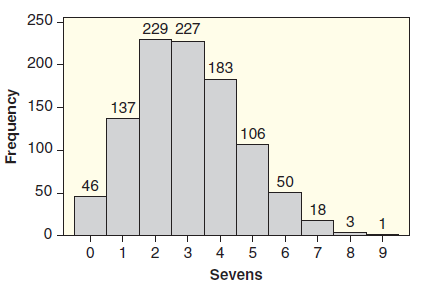Thirty students are asked to choose a random number between 0 and 9, inclusive, to create a
Question:
SeeFigure 4.21.

(a) Notice that this randomization distribution is not symmetric. This is a two-tailed test, so we need to consider both €˜€˜tails.€ How far is X = 8 from the expected value of 3? What number would be equally far out on the other side? Explain why it is better in this situation to double the observed one-tailed p-value rather than to add the exact values on both sides.
(b) What is the p-value for the observed statistic of X = 8 sevens when doing the two-tailed test?
(c) The randomization distribution in Figure 4.21 would apply to any digit (not just 7€™s) if the null hypothesis is H0: p = 0.1. Suppose we want to test if students tend to avoid choosing zero when picking a random digit. If we now let p be the proportion of 0€™s all students choose, the alternative would be Ha: p < 0.1. What is the smallest p-value we could get using the randomization distribution in Figure 4.21? What would have to happen in the sample of digits from 30 students for this p-value to occur?
DistributionThe word "distribution" has several meanings in the financial world, most of them pertaining to the payment of assets from a fund, account, or individual security to an investor or beneficiary. Retirement account distributions are among the most...
Step by Step Answer:

Statistics, Enhanced Unlocking The Power Of Data
ISBN: 9781119308843
2nd Edition
Authors: Robin H Lock, Patti Frazer Lock, Kari Lock Morgan, Eric F Lock, Dennis F Lock





